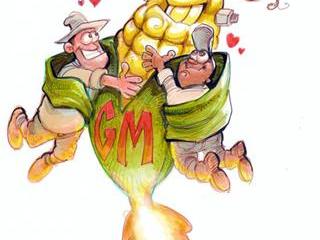
Plantings of genetically modified (GM) maize, soya beans and cotton in South Africa are increasing at an unprecedented rate. In 2010, the biotech crop area increased by 1 million hectares compared to 2009, the 13th consecutive increase, according to a Maize Trust-funded survey on GM crops in South Africa conducted in December 2010.
The total biotech crop area in South Africa for 2010 was conservatively estimated at 2,2 million hectares. The total maize crop, down 10% from 2009, was about 2,47 million hectares, with 1,90 million hectares (76,9%) being GM crops. Single Bt crops comprised 45,6%, herbicide tolerant crops 13,4%, and stacked Bt and herbicide tolerant crops 41% (A plant with stacked genes contains two or more transgenes).
The total white maize crop represented 1,52 million hectares, with 74,8% being GM. Yellow maize comprised 0,94 million hectares, of which 80,2% was GM. Smallholder farmers planted 19 000ha of GM maize in 2009. For the 10-year period 2001 to 2010, an accumulative 10 million hectares of GM maize was planted in South Africa, producing a grain crop of over 38 million mega tons.
This grain was consumed annually by more than 40 million people, as well as by 800 million broilers, 1,4 million feedlot cattle and 3 million pigs slaughtered at formal abattoirs, without any scientific or medically substantiated incidences of adverse effects on humans, animals or the environment.
Soya bean plantings increased by 78 550ha from 311 450ha in 2009 to over 390 000ha in 2010. At least 85% was biotech herbicide tolerant. As a result of higher cotton prices, the area planted to cotton, 100% biotech, doubled to 15 000ha and 95% stacked. The value of biotech crops from 1998 to 2009 was US$676 million (R4,7 billion), R1 billion in 2009 alone (Barfoot & Brookes global survey, 2011 forthcoming).
Modern biotechnology addresses production constraints to the benefit of sustainable agriculture and food security. New modifications in field trials combine various insect resistance and herbicide tolerant traits. These include 21 different stacked GM traits in maize and nine in cotton. Apart from drought-tolerant maize, three GM sugar cane lines with growth rate, yield and altered sugar benefits, GM cassava, and a GM table grape variety are being field tested. GM maize with two Bt genes and herbicide tolerance was approved for commercial release in 2010.
Africa
South Africa is the biotech driving force in Africa and is ranked seventh among biotech mega countries in the world. Egypt and Burkina Faso are the only two other African countries growing commercial GM crops and these are expanding rapidly. In 2010, Burkina Faso planted 260 000ha (115 000ha in 2009) of Bt cotton farmed by 80 000 farmers on less than 3ha of land each. This represents an increase of 126%. The cotton seed was researched and produced in South Africa.
Egypt planted 2 000ha of Bt maize, the first Arab country to do so. The seed was also researched and produced in South Africa.
Several other countries – Kenya, Tanzania, Uganda, Malawi, Mali and Ghana – are in advanced stages of conducting research and field trials with numerous GM crops including maize, rice, wheat, cassava, bananas, sorghum and cotton.
Global adoption
According to a global report by the International Service for the Acquisition of Agri-Biotech Applications (ISAAA), in 2010 a record 15,4 million farmers in 29 countries on all six continents grew 148 million hectares of GM crops. This represents an increase of 10% or 14 million hectares.
Three new nations approved biotech crops for the first time. In Pakistan, 600 000 farmers planted 2,5 million hectares, in Myanmar 375 000 farmers planted more than 300 000ha of insect-resistant Bt cotton, and Sweden planted a new biotech high quality starch ‘Amflora’ potato.
In 2010, 15 years after commercialisation, accumulated global biotech crop production exceeded 1 billion hectares. In addition to the 29 biotech countries, another 30 countries have approved the importation of biotech crops for food and feed, totalling 59 countries that have approved the use of biotech crops.
Notably, over 90% of the 15,4 million biotech farmers in 2010 were small, resource-poor farmers. The five principal biotech developing countries – China, India, Brazil, Argentina and South Africa – planted 63 million hectares of biotech crops, equivalent to 43% of the global total. Brazil had a record increase of 4 million hectares, totalling 25,4 million hectares of soya beans, maize and cotton – the largest crop area increase worldwide.
The EU
Led by Spain, eight EU countries planted a combined 91 193ha of Bt maize. The EU imports 33 million mega tons of soya beans, 95% of which is GM, from Argentina, the US and Brazil for food and feed but prevents its own farmers from planting the crop. After joining the EU, Romania was banned from planting RR (Roundup Ready) soya beans. According to Romania’s minister of agriculture, the EU ban costs Romania US$131 million annually.
Worldwide, biotech soya beans was the principal biotech crop in 2010, occupying 50% of the global biotech area. Maize was second at 31%. Cotton came third at 14%. In 2010 herbicide tolerant soya beans, maize, canola, cotton, sugar beet and lucerne crops occupied 61% of the global biotech area of 148 million hectares. Stacked traits are becoming an important trend. Since certain testing procedures may count a GMO with stacked genes twice, stacked traits may be difficult to handle when quantifying the GMO content of a sample. In 2010, a total of 32,3 million hectares (22%) of the 148 million hectares were stacked.
The benefits?
According to the International Service for the Acquisition of Agri-biotech Applications (ISAAA), future biotech crops include drought-tolerant maize (in 2012); biotech wheat with drought tolerance, disease resistance and grain quality; biotech potatoes resistant to late blight (in 2015); sugar cane with improved agronomic and quality traits; disease-resistant bananas; Bt eggplant, tomato, broccoli, cabbage, cassava and sweet potato.
At the current adoption rate, ISAAA predicts that by 2015 an additional 150 million hectares of biotech crops will be added. The ISAAA report emphasises the important contribution of biotech crops on yield gains, increased productivity, biodiversity and environmental conservation.
From 1996 to 2009, substantial yield gains of 229 million tons and economic benefits of US$65 billion were generated globally at farm level as a result of reduced input cost, less pesticide sprays, less labour and reduced use of fossil fuels. Conventional cropping would have required an additional 75 million hectares. Environmental conservation saved 393 million kilograms active pesticide ingredients. (Barfoot & Brookes, 2011)
The views expressed in our weekly opinion piece do not necessarily reflect those of Farmer’s Weekly.













